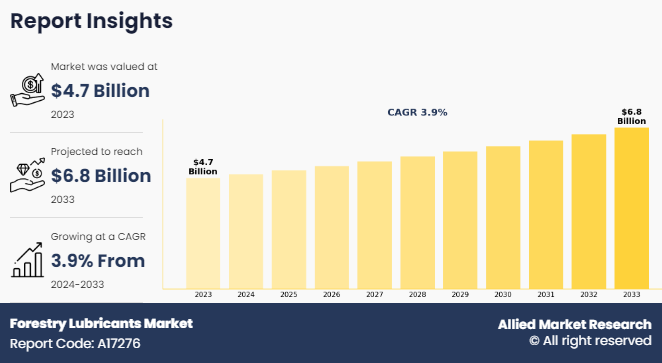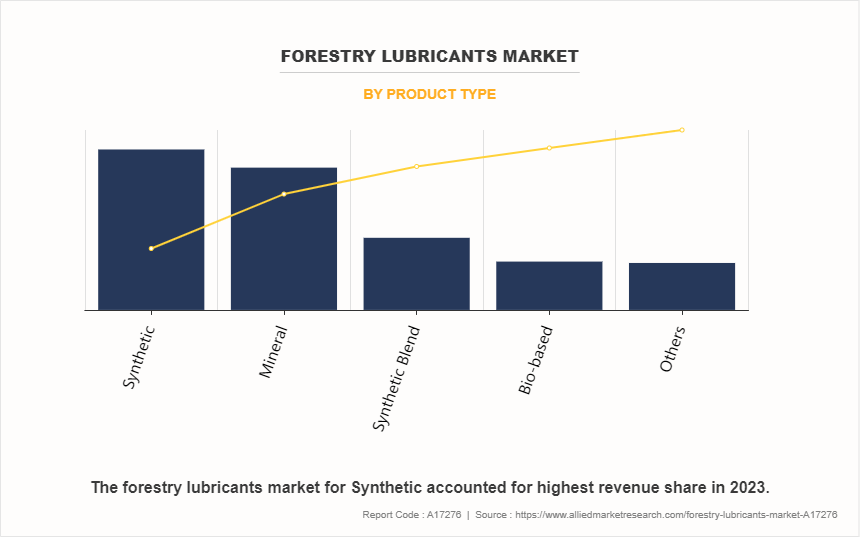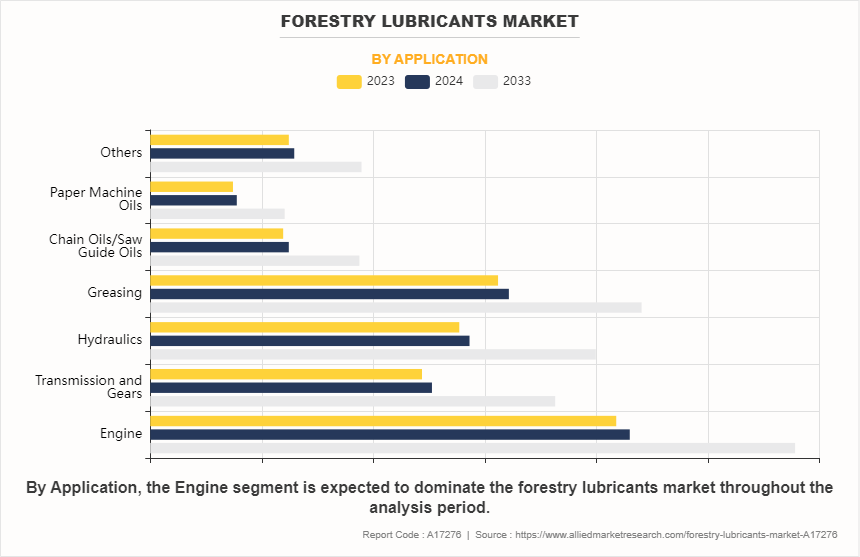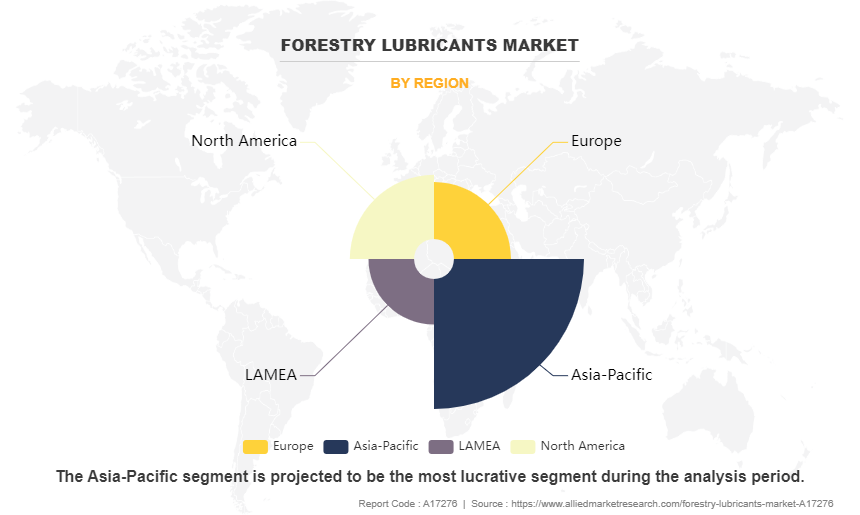Forestry Lubricants Market Research, 2033
The global forestry lubricants market size was valued at $4.7 billion in 2023, and is projected to reach $6.8 billion by 2033, growing at a CAGR of 3.9% from 2024 to 2033. The longevity of forestry equipment is a critical consideration for operators, as the cost of purchasing and maintaining machinery represents a significant investment. Forestry lubricants offer superior protection against wear and environmental stressors contribute to the extended lifespan of equipment, which in turn helps operators achieve a better return on investment. By reducing the frequency of part replacements and repairs, these lubricants support the long-term sustainability of forestry operations and make them more economically viable.

Introduction
Forestry lubricants are specialized oils, greases, and fluids designed to reduce friction, wear, and corrosion in machinery and equipment used in forestry operations. These lubricants are formulated to withstand the harsh and demanding conditions typical of forestry work, such as exposure to extreme temperatures, heavy loads, moisture, and abrasive materials such as dirt and debris. By ensuring smooth and reliable operation, forestry lubricants help maintain the efficiency, performance, and longevity of equipment such as chainsaws, harvesters, skidders, and loaders, which are essential for tasks such as logging, tree cutting, and wood processing.
Key Takeaways
The global forestry lubricants market has been analyzed in terms of value ($billion). The analysis in the report is provided on the basis of product type, application, 4 major regions, and more than 15 countries.
The global forestry lubricants market report includes a detailed study covering underlying factors influencing the industry opportunities and trends.
The key players in the forestry lubricants market are Chevron Corporation, Cortec Corporation, Exxon Mobil Corporation, Frontier Performance Lubricants INC, FUCHS, Penine Lubricants, Phillips 66 Company, Repsol, Rymax Lubricants, TotalEnergies, Petro‐Canada Lubricants Inc, Shell Plc, THERMAL-LUBE, INC, Morris Lubricants, Matrix Specialty Lubricants, Zeller+Gmelin, MOL Group, CONDAT Group, Neste, and Exol Lubricants Limited.
The report facilitates strategy planning and industry dynamics to enhance decision making for existing market players and new entrants entering the alternators industry.
Countries such as China, the U.S., Canada, Germany, and Brazil hold a significant share in the global forestry lubricants market.
Market Dynamics
In forest industry where machinery is subjected to extreme conditions such as heavy loads, high temperatures, and constant exposure to dust, dirt, and moisture, the performance and reliability of equipment are important. Lubricants play a crucial role in minimizing friction, reducing wear and tear, and protecting vital components, thereby enhancing both operational efficiency and the lifespan of equipment. In addition, high-quality lubricants that are specifically formulated for forestry applications help to mitigate these risks by providing superior protection against corrosion, oxidation, and mechanical wear. By reducing the frequency of maintenance and the likelihood of breakdowns, these lubricants enable operators to maintain continuous and efficient operations, maximizing productivity and minimizing costs. All these factors are expected to drive the growth of the global forestry lubricants market during the forecast period.
However, as environmental awareness and regulations increase, there is a growing demand for sustainable and biodegradable lubricants that minimize ecological impact. However, the development and commercialization of such products have not kept pace with the demand, leading to a scarcity of options that meet both performance and environmental standards. The formulation of eco-friendly lubricants requires advanced R&D efforts to ensure that these products perform under the harsh conditions typical of forestry operations. Traditional lubricants, which are petroleum-based, have well-established performance records, while eco-friendly alternatives must prove their efficacy in areas such as high load bearing, extreme temperature resistance, and long-term durability. This R&D process is costly and time-consuming, leading to fewer products being available on the market. All these factors hamper the forestry lubricants market growth.
Technological advancements are paving the way for more environmentally friendly lubricant formulations. Researchers are developing bio-based lubricants derived from renewable resources such as vegetable oils, that are biodegradable and non-toxic. These eco-friendly alternatives are designed to meet stringent environmental regulations without compromising on performance. The ability to offer high-performance lubricants that also reduce the environmental impact of forestry operations is a significant market opportunity, as sustainability becomes an increasingly important consideration for companies and regulators alike. All these factors are anticipated to offer new growth opportunities in the forestry lubricants market forecast.
Segments Overview
The forestry lubricants industry is segmented into product type, application, and region. On the basis of product type, the market is divided into synthetic, synthetic blend, bio-based, mineral, and others. By application, the market is segmented into engine, transmission and gears, hydraulics, greasing, chain oils/saw guide oils, paper machine oils, and others. Region-wise, the market is analyzed across North America, Europe, Asia-Pacific and LAMEA.

On the basis of product type, the market is divided into synthetic, synthetic blend, bio-based, mineral, and others. The synthetic segment accounted for more than one-third of the forestry lubricants market share in 2023 and is expected to maintain its dominance during the forecast period. Synthetic lubricants are engineered to provide enhanced protection in extreme temperatures, both high and low. This is crucial in forestry operations where equipment operates in harsh environmental conditions, including intense heat during the summer and severe cold in the winter. The ability of synthetic lubricants to maintain their viscosity and lubricating properties across a wide temperature range ensures that forestry machinery operates smoothly and efficiently, reducing downtime and maintenance costs.

By application, the market is segmented into engine, transmission and gears, hydraulics, greasing, chain oils/saw guide oils, paper machine oils, and others. The engine segment accounted for more than one-fourth of the forestry lubricants market share in 2023 and is expected to maintain its dominance during the forecast period. The drive for cost-efficiency in forestry operations influences the demand for high-performance lubricants. Lubricants provide extended oil change intervals and enhanced engine protection reduce downtime and maintenance costs. The ability of these lubricants to operate effectively over longer periods without degradation is essential in ensuring the continuous operation of forestry equipment, which is often far from maintenance facilities. This need for reliability and durability in challenging environments drives the demand for forestry lubricants in engines.

Region-wise, the market is analyzed across North America, Europe, Asia-Pacific and LAMEA. The Asia-Pacific region accounted for more than two fifth of the forestry lubricants market share in 2023 and is expected to maintain its dominance during the forecast period. Asia-Pacific region's rapidly expanding forestry industry, particularly in countries such as China, India, and Indonesia, is a major contributor. As these nations continue to industrialize and urbanize, the demand for wood and wood-based products increased that drive the need for efficient and reliable forestry machinery. All these factors drive the demand for high-performance lubricants that ensure the smooth operation of equipment under harsh working conditions typical in forestry activities.
Competitive Analysis
Key players in the forestry lubricants market include Chevron Corporation, Cortec Corporation, Exxon Mobil Corporation, Frontier Performance Lubricants INC, FUCHS, Penine Lubricants, Phillips 66 Company, Repsol, Rymax Lubricants, TotalEnergies, Petro‐Canada Lubricants Inc, Shell Plc, THERMAL-LUBE, INC, Morris Lubricants, Matrix Specialty Lubricants, Zeller+Gmelin, MOL Group, CONDAT Group, Neste, and Exol Lubricants Limited.
In the global forestry lubricants market, companies have adopted agreement and acquisition strategies to expand the market or develop new products. For instance, in November 2021, TotalEnergies has signed an agreement with the Government of Suriname to provide support for its national strategy to reduce greenhouse gas emissions by preserving forests in the country. This public-private partnership illustrates the alignment between the ambition of Total Energies and the Government of Suriname to protect forest ecosystems and biodiversity while benefiting local communities. Moreover, in July 2021, Cortec Corporation invites loggers to add a new dimension to sustainable forestry by implementing EcoLine biobased lubricants into their daily equipment maintenance tasks
Key Benefits For Stakeholders
This report provides a quantitative analysis of the market segments, current trends, estimations, and dynamics of the forestry lubricants market analysis from 2023 to 2033 to identify the prevailing forestry lubricants market opportunities.
The market research is offered along with information related to key drivers, restraints, and opportunities.
Porter's five forces analysis highlights the potency of buyers and suppliers to enable stakeholders make profit-oriented business decisions and strengthen their supplier-buyer network.
In-depth analysis of the forestry lubricants market segmentation assists to determine the prevailing market opportunities.
Major countries in each region are mapped according to their revenue contribution to the global market.
Market player positioning facilitates benchmarking and provides a clear understanding of the present position of the market players.
The report includes the analysis of the regional as well as global forestry lubricants market trends, key players, market segments, application areas, and market growth strategies.
Forestry Lubricants Market Report Highlights
| Aspects | Details |
| Market Size By 2033 | USD 6.8 billion |
| Growth Rate | CAGR of 3.9% |
| Forecast period | 2023 - 2033 |
| Report Pages | 354 |
| By Product Type |
|
| By Application |
|
| By Region |
|
| Key Market Players | THERMAL-LUBE, INC, Phillips 66 Company, Exol Lubricants Limited, FUCHS, MOL Group, Zeller+Gmelin, Penine Lubricants, Exxon Mobil Corporation, CONDAT Group, Shell plc, Petro?Canada Lubricants Inc, Chevron Corporation, Morris Lubricants, Matrix Specialty Lubricants, Frontier Performance Lubricants INC., Cortec Corporation, Rymax Lubricants, Neste, Total Energies, Repsol |
Analyst Review
According to the opinions of various CXOs of leading companies, the forestry lubricants market is expected to witness an increase in demand during the forecast period. Operational efficiency and equipment longevity and expansion of forestry operations in emerging markets have increased the demand for forestry lubricants during the forecast period. In forestry operations, machinery is subject to intense conditions, including heavy loads, extreme temperatures, and exposure to abrasive materials such as dust and debris. To maintain efficiency, it is essential that this equipment operates smoothly with minimal downtime. High-performance lubricants play a crucial role in reducing friction, preventing wear and tear, and protecting against corrosion, thereby ensuring that machinery continues to function optimally even under these demanding conditions. By enhancing the efficiency of forestry equipment, these lubricants help operators achieve greater productivity and reduce maintenance costs, leading to a strong demand for reliable and effective lubricants in the industry.
Moreover, the expansion of forestry operations in emerging markets has also fueled the increased demand for forestry lubricants. Countries in regions such as Southeast Asia, Africa, and Latin America are experiencing rapid economic growth, leading to an increased exploitation of forest resources to meet global demand for timber, paper, and other forest products. As these countries invest in the development and mechanization of their forestry sectors, the need for high-quality lubricants becomes more pronounced. These markets often involve challenging environmental conditions that place additional stress on machinery, making it essential to use lubricants that withstand these harsh environments and ensure the longevity of expensive forestry equipment.
$6.8 billion is the estimated industry size of Forestry Lubricants by 2033.
Rising demand for high-performance machinery in forestry operations and Increased focus on equipment longevity and maintenance efficiency are the upcoming trends of Forestry Lubricants Market in the world.
Engine is the leading application of Forestry Lubricants Market
Asia-Pacific is the largest regional market for Forestry Lubricants.
Chevron Corporation, Cortec Corporation, Exxon Mobil Corporation, Frontier Performance Lubricants INC, FUCHS, Penine Lubricants, Phillips 66 Company, Repsol, Rymax Lubricants, TotalEnergies, Petro?Canada Lubricants Inc, Shell Plc, THERMAL-LUBE, INC, Morris Lubricants, Matrix Specialty Lubricants, Zeller+Gmelin, MOL Group, CONDAT Group, Neste, and Exol Lubricants Limited are the top companies to hold the market share in Forestry Lubricants
Loading Table Of Content...
Loading Research Methodology...



